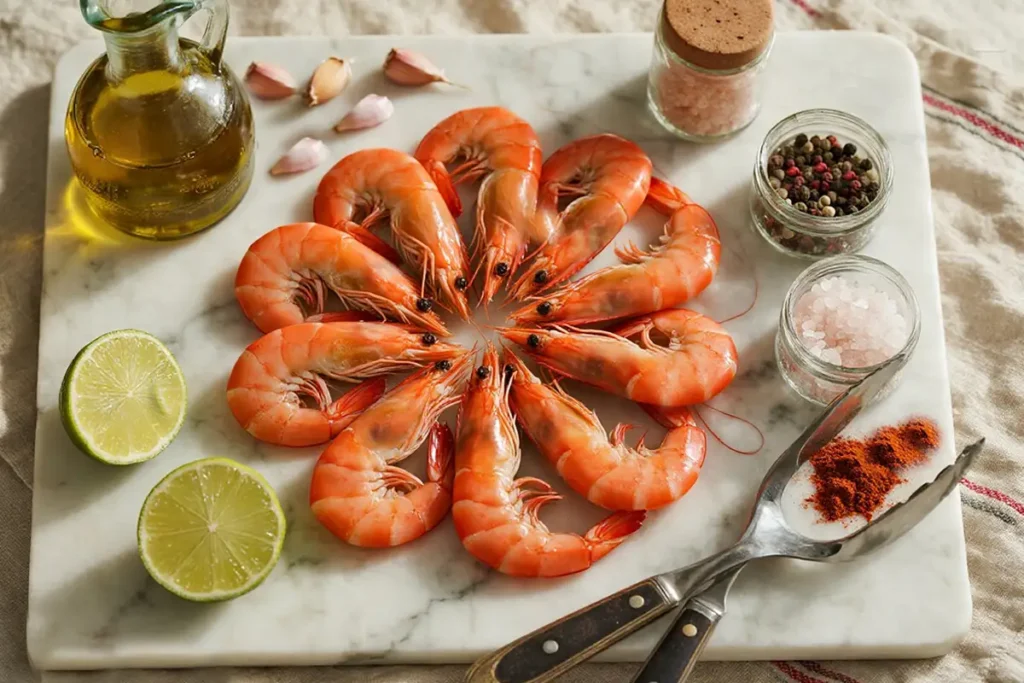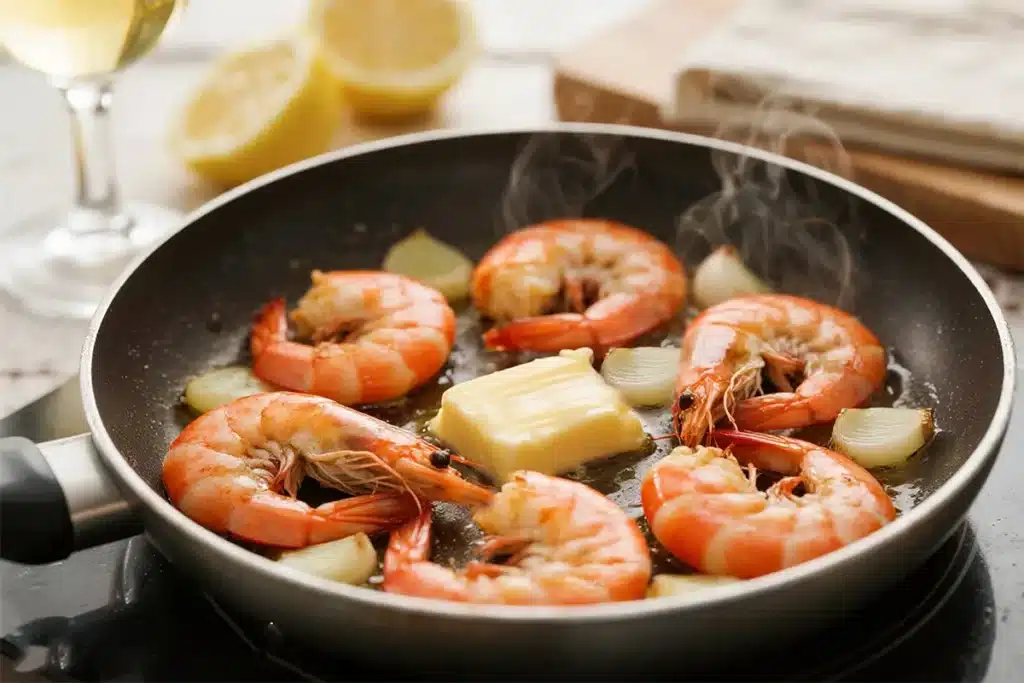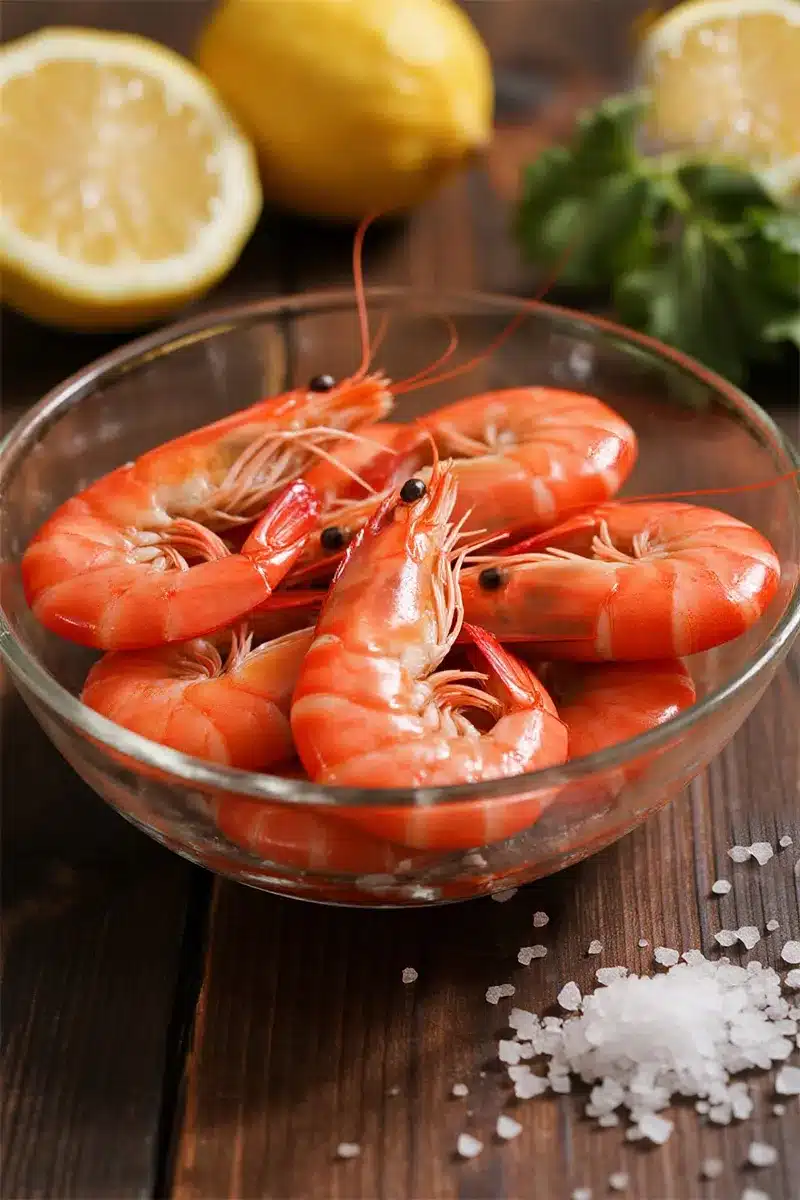What Makes Red Shrimp So Unique?
Argentine Red Shrimp Taste is unlike anything you’ll find in the average seafood aisle. You’ve probably seen these vibrant, ruby-red shrimp in the freezer section and wondered if they were already cooked. The truth is, that bold color is completely natural. These aren’t dyed or processed, they’re wild Argentine red shrimp (Pleoticus muelleri), celebrated as the “lobster of the sea” for good reason.
Unlike Pacific white shrimp with their mild, sometimes bland profile, Argentine red shrimp deliver a flavor that’s rich, sweet, and buttery. They aren’t just another seafood option—they’re a premium upgrade. Caught in the cold, deep waters off Argentina’s coast, their delicate texture and bold flavor set them apart from the rest.
If you’ve ever wondered why chefs and seafood lovers rave about them, it’s simple: Argentine red shrimp taste expensive, and they don’t need heavy sauces or complicated recipes to shine.
Want to try them in a simple, elegant dish? Check out our guide on Air Fryer Pomegranate Glazed Salmon, another naturally sweet seafood favorite.
Table of Contents
Argentine Red Shrimp Taste: The Complete Guide to the ‘Lobster of the Sea’
A quick and simple recipe to enjoy Argentine red shrimp at their best — sweet, buttery, and lobster-like in flavor. Perfect for showcasing their natural taste.
- Prep Time: 10 mins
- Cook Time: 5 mins
- Total Time: 15 mins
- Yield: 4 servings 1x
- Category: Seafood
- Method: Sauté
- Cuisine: Argentine
Ingredients
1 lb Argentine red shrimp (peeled & deveined)
2 tbsp olive oil or butter
2 cloves garlic, minced
1 lemon (juice + zest)
Salt to taste
Fresh parsley for garnish
Instructions
1. If frozen, thaw Argentine red shrimp overnight in the fridge or under cold water.
2. Pat shrimp dry with paper towels to maintain texture.
3. Heat olive oil or butter in a skillet over medium-high heat.
4. Add garlic and sauté for 30 seconds until fragrant.
5. Add shrimp and cook 60–90 seconds per side until just opaque.
6. Squeeze lemon juice over shrimp, add zest, and season with salt.
7. Garnish with fresh parsley and serve immediately.
Notes
Do not overcook, Argentine red shrimp cook faster than regular shrimp.
Best served simply to highlight their natural sweet, buttery taste.
Optional: Try them raw in ceviche or grilled for smoky flavor.
Air Fryer Option: Lightly oil shrimp and cook at 400°F for 6–8 minutes, flipping halfway.
Nutrition
- Serving Size: 4 shrimp
- Calories: 190
- Sugar: 0g
- Sodium: 380mg
- Fat: 9g
- Saturated Fat: 2g
- Unsaturated Fat: 7g
- Trans Fat: 0g
- Carbohydrates: 2g
- Fiber: 0g
- Protein: 24g
- Cholesterol: 120mg

What Does Argentine Red Shrimp Taste Like? Sweet, Briny & Buttery
Unmatched Sweetness
The standout feature of Argentine red shrimp is their natural sweetness, a quality rarely found in other shrimp varieties. This isn’t added sugar or seasoning; it’s built into the meat. Their diet of nutrient-rich plankton in frigid South Atlantic waters contributes to a higher natural sugar content, giving them a subtle, almost lobster-like sweetness that lingers on the palate.
It’s this sweetness that makes them perfect for dishes where the shrimp is the star, no heavy sauces needed.
Tender, Not Tough
Forget rubbery shrimp. Argentine red shrimp are prized for their tender, melt-in-your-mouth texture. Their flesh is softer and more delicate than white shrimp, with a buttery mouthfeel that feels indulgent with every bite.
Because of this tenderness, they cook incredibly fast, often in under two minutes when sautéed or fried. Overcook them, and you’ll lose that luxurious softness, so timing is everything.
A Hint of Brine
They carry a clean, crisp oceanic note, a hint of brine that enhances their freshness without any fishy aftertaste. Unlike some farmed shrimp that can taste muddy or chemically, Argentine red shrimp taste pure and bright, reflecting the pristine environment they come from.
This clean finish makes them ideal for raw preparations like ceviche or tartare, where purity of flavor is key.
How Its Appearance Affects the Taste Experience
Those striking red shells aren’t just eye-catching, they’re a visual clue to the shrimp’s quality. The deep red color is entirely natural, thanks to carotenoids in their diet, the same pigments that give salmon its pink hue.
This vibrant shade isn’t just beautiful, it signals a mineral-rich, healthy life in cold, oxygenated waters. And that directly translates to better flavor. When you see those ruby-colored shrimp, know you’re looking at seafood that’s not only safe to eat raw but packed with natural sweetness and depth.
Argentine Red Shrimp vs. Traditional White Shrimp
Let’s break down the differences so you know exactly what you’re getting:
| Texture | Soft, tender, buttery | Firm, snappy, chewy |
| Flavor | Naturally sweet, lobster-like | Mild, neutral, sometimes bland |
| Cooking Time | 1–2 minutes (very fast) | 3–5 minutes |
| Best Use | Searing, grilling, raw prep | Curries, stews, heavily seasoned dishes |
Because red shrimp are so delicate, they’re best suited for quick, high-heat cooking methods. Save the long simmers for tougher white shrimp.
And yes; because they’re so flavorful, you can skip the marinades. A little salt, lemon, and garlic are all they need.
Best Ways to Cook Red Shrimp (To Maximize Flavor)
The secret to enjoying Argentine red shrimp at their best? Keep it simple. Let their natural flavor take center stage.
Quick Sauté/Sear

Heat a pan with olive oil or butter, add peeled shrimp, and cook 60–90 seconds per side until just opaque. Finish with a squeeze of lemon and fresh herbs. Done.
Grilling/Broiling
Thread onto skewers or use a grill basket. High heat for 1–2 minutes per side gives you smoky edges while keeping the inside tender.
Air Frying (Fast & Crispy)
For a healthier crunch, toss in light oil and air fry at 400°F for 6–8 minutes. It’s a great alternative to deep frying. Try pairing with techniques from our Air Fryer Catfish Nuggets guide.
Serving Raw
Yes, they’re safe for raw dishes, if sourced from a reputable supplier. Their sweetness shines in shrimp ceviche or sushi-grade preparations. Just ensure they’re labeled sushi-safe and kept cold.
Avoid heavy breading or overpowering sauces, they’ll mask the very qualities that make these shrimp special.
If you love fast, crispy results, try air frying your shrimp — just like in our Tyson Panko Chicken Breast Air Fryer guide, where speed meets crunch.
FAQ: Sourcing, Safety, and Substitutions
Q: Is it safe to eat if it’s already red when raw?
Yes. Argentine red shrimp are naturally red even when raw. The vibrant color comes from carotenoids in their diet, not from cooking or dyes. It’s completely safe and a signature trait that signals their premium quality.
Q: How can I tell if the shrimp is fresh?
Look for shrimp with a firm, glossy texture and no ammonia-like smell. Fresh Argentine red shrimp should smell clean and oceanic. Frozen is often a better choice than “fresh” at the counter since it’s usually frozen right after harvest.
Q: Does it cost more than regular shrimp?
Yes, Argentine red shrimp usually cost more than white or farmed shrimp. That higher price reflects their superior taste, buttery texture, and wild-caught origins. Think of it as paying for a gourmet experience.
Q: Are Argentine red shrimp sweet?
Absolutely. Their natural sweetness is their defining trait, often compared to lobster. That’s why the phrase “argentine red shrimp taste” almost always highlights their rich, buttery-sweet flavor.
Q: Are Argentinian shrimp fishy?
No. Argentine red shrimp taste clean and briny without any muddy or fishy aftertaste. This makes them ideal for raw dishes like ceviche or sushi.
Q: What’s special about Argentine red shrimp?
Their unique combination of sweetness, buttery texture, and natural red color sets them apart. Unlike common shrimp, they cook in under two minutes and deliver a flavor closer to lobster than to standard shrimp.
Q: Why avoid Argentine red shrimp?
The main concern is sustainability. Some trawling practices can affect ecosystems. To enjoy them responsibly, look for MSC-certified Argentine red shrimp from trusted suppliers.
Conclusion: Transform Your Next Meal
Argentine red shrimp aren’t just another protein option—they’re a culinary experience. With their sweet, buttery flavor and delicate texture, they bring restaurant-quality elegance to your kitchen with minimal effort.
Whether you sear them quickly in a pan or serve them raw in a citrusy ceviche, one bite will show you why they’re called the “lobster of the sea.”
Ready to explore more premium flavors? Try our Air Fryer Chuck Roast for a hearty, savory contrast to this delicate seafood.
Simple, stunning, and unforgettable, this is how shrimp should taste.
End your meal on a creamy note with a glass of taro milk tea or a spoonful of coffee budino — both rich, satisfying, and easy to make.


